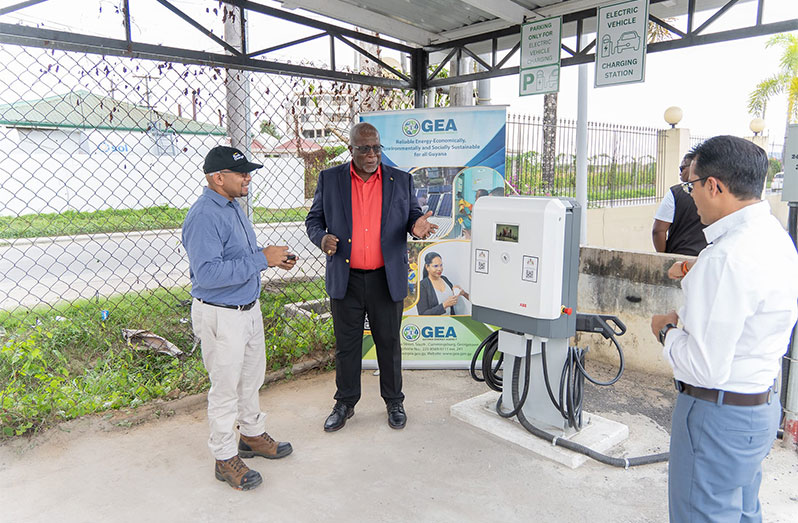-as Guyana forges ahead with clean, renewable energy transition
-GEA mulls plans for additional stations, expansion
ELECTRIC vehicle charging stations are now available at several locations across Guyana, providing easy accessibility to hundreds of vehicle owners.
During a site visit to one of six stations located at Amazonia Mall in Providence, Prime Minister, Brigadier (Ret’d), Mark Phillips disclosed that the $39.3 million investment is part of the government’s Low Carbon Development Strategy (LCDs) to facilitate the robust transition from fossil fuels to renewable energy.
“[This] fits quite nicely into our Low Carbon Development Strategy 2030, and you know, through the LCDs 2030, we are encouraging more use of renewable energy sources. In this case motor vehicles can transition from using gasoline or diesel vehicles, which is fossil fuel,” the Prime Minister said, adding:
“Now we have these public charging stations which makes the ability to charge your vehicle on the move more [accessible] now.”

Charging stations have been installed at Amazonia Mall in Providence, the Cheddi Jagan International Airport (CJIA) in Timehri, the Giftland Mall on the East Coast of Demerara, Little Rock Suites in New Amsterdam, S&R Parking Lot in Parika, and outside of the GEA’s Office on Quamina Street, Georgetown.
These stations are currently under a three-month trial and testing phase and are being monitored by the Guyana Energy Agency (GEA) engineers. During this period, consumers can recharge their vehicles free.
To use the stations, vehicle owners can simply download the “Flash Charge” app, register, and charge their vehicles at any of the six locations across the country.
“This fits nicely into our transition of fossil fuel to renewable energy…this is the future,” Prime Minister Phillips said.
He further urged Guyanese to invest in electric vehicles to further support the government’s efforts in transitioning to renewable energy and safeguarding the environment.
“Government has also removed the 14 per cent tax on vehicles in order to encourage greater use of electric vehicles and there are concessions that we have made available… even the government agencies I’m calling on my fellow ministers, so we will lead the way in investing and purchasing electric vehicles and make the facility more available in terms of charging.”
According to the prime minister, a budgetary allocation will be made in 2024 to facilitate the installment of more infrastructure to support electric vehicle charging.
Prime Minister Phillips also emphasised the competitive pricing, stating, “At $80 per kilowatt-hour, that’s very affordable for anybody with an electric vehicle,” as he compared it to other Caribbean charging rates for electric vehicles ranging from G$81-G$176 per kWh, and $156-G$183 per kWh.

This project promotes e-mobility development, demonstrates potential business opportunities in electric mobility, and signals the market’s readiness for an electric vehicle’s future.
Meanwhile, Chief Executive Officer of Guyana Energy Agency, Dr. Mahendra Sharma, revealed that the GEA is examining various technologies and engaging local partners to make the infrastructure more accessible.
“The total cost that we paid to install these units is $39.3 million; that’s about $ 1.5 million per unit. We want to look at other types of technology other brands to see how we could lower that cost. We had a lot of difficulty getting that credit card system to work because of the small volume. We want to look at local payment options as well, we are going to start working with a local service provider to see how we can incorporate them to make it accessible to a larger group.”
At $80 per kilowatt, vehicle owners can fully charge their vehicles at the cost of $2500 to $4000 depending on the model and battery capacity of the vehicle.
CONVENIENT
Already vehicle owners have been able to use the stations that have been installed across the country.
Samuel Chandool, the owner of an electric car, shared that he was able to make a recent trip from Timehri (region four) to Crabwood Creek in region six.
“Because of the charging stations I was able to do a trip from Timerhi to Crabwood Creek the other day and come down back without having to stop for additional charge which is good, before that would have been difficult to do without the charging stations.”
Chandool disclosed that he visited four of the six locations that have been set across the country.
Meanwhile, Christina De Oliveira noted that the new infrastructure has made travelling a lot more convenient.
Previously, she would have recharged her vehicle at home but now can do so on the go.
In order to provide more Guyanese with access to energy-efficient and carbon dioxide-reducing alternative mobility options, the government announced fiscal initiatives; these included the removal of 14 per cent tax on brand-new, non-hybrid electric motor vehicles and an annual increase to 50 per cent of the writing down allowance for all-electric motor vehicles in order to encourage businesses to make the investment decision to transition to greener cars.



.jpg)









